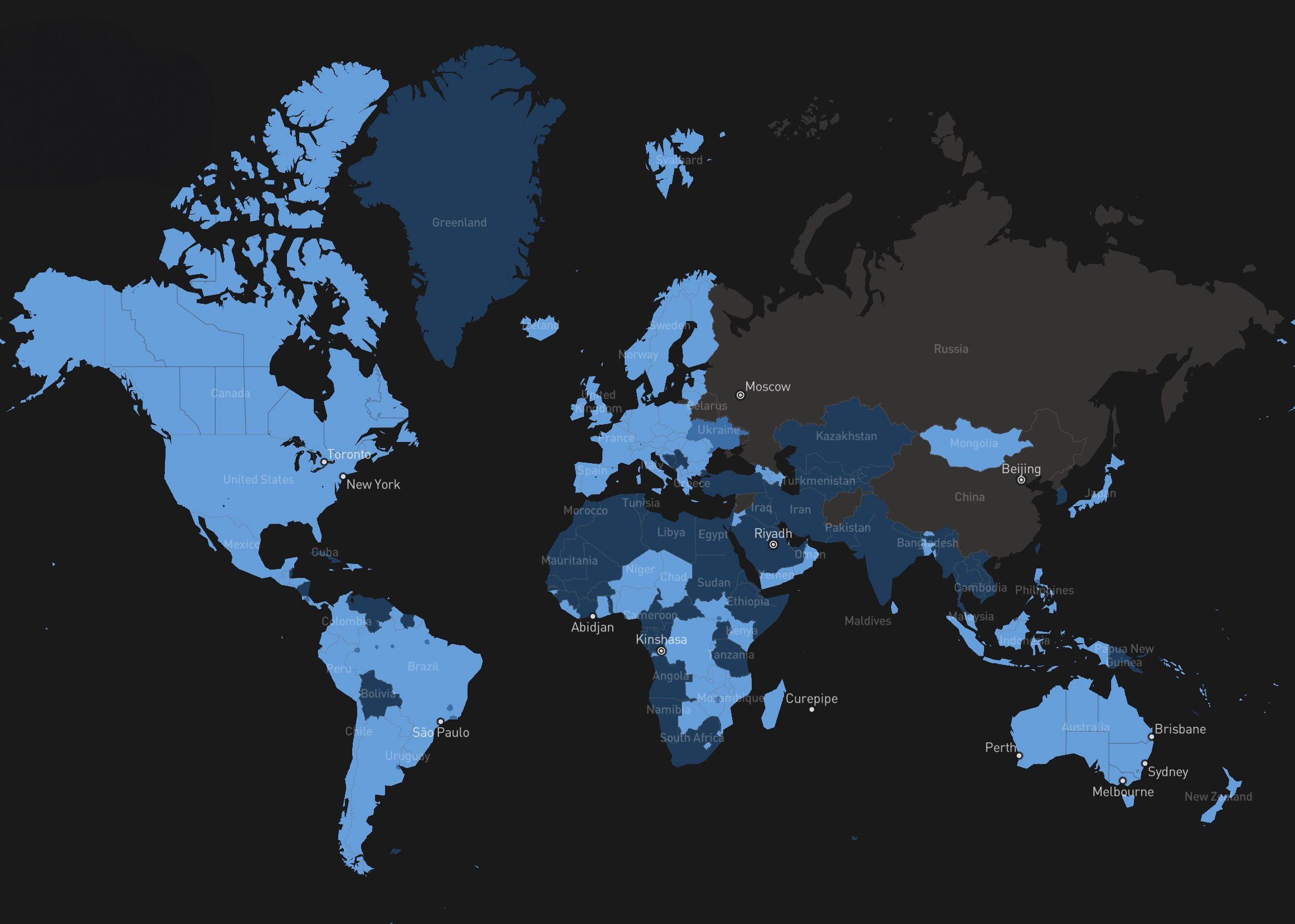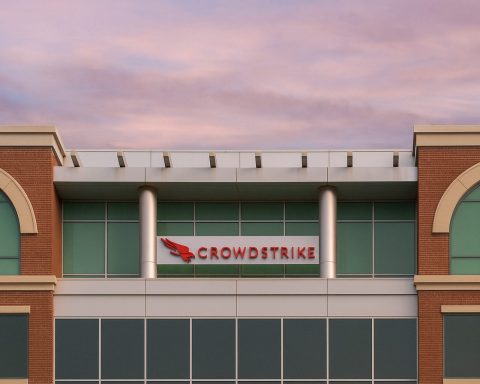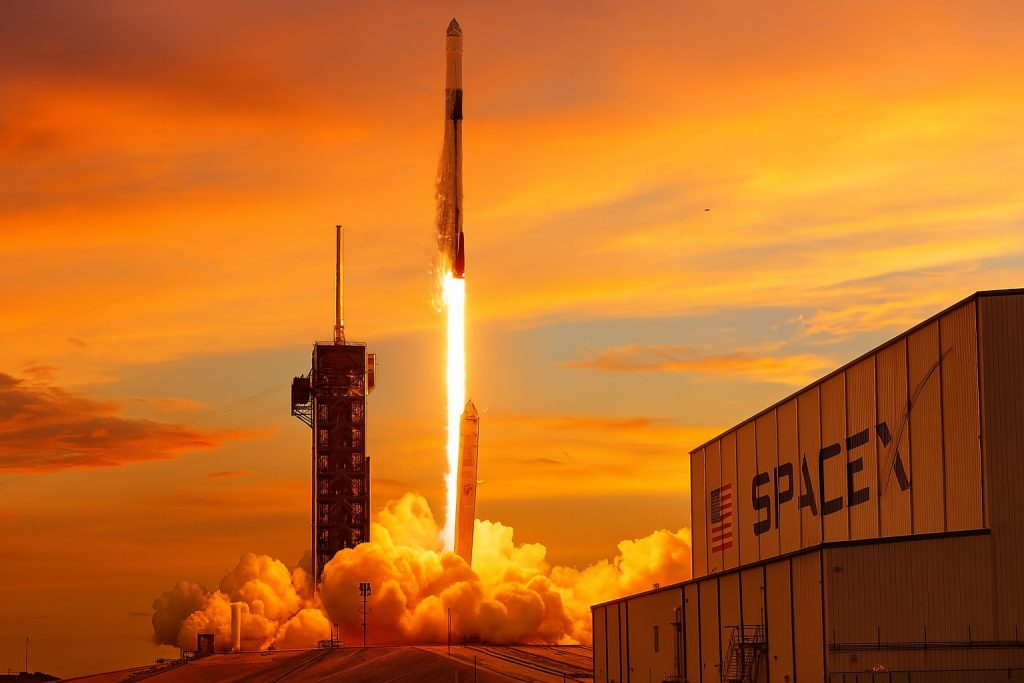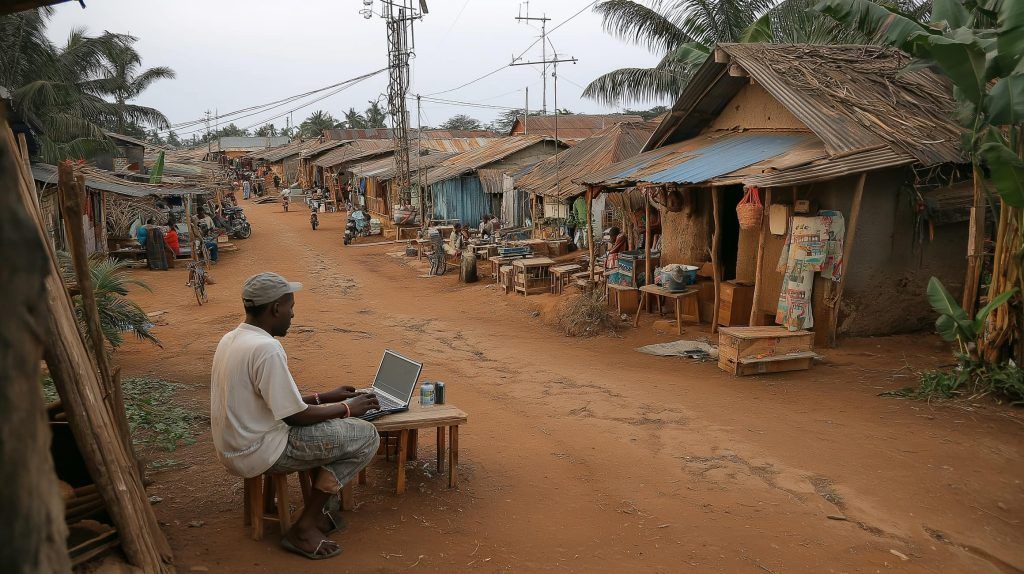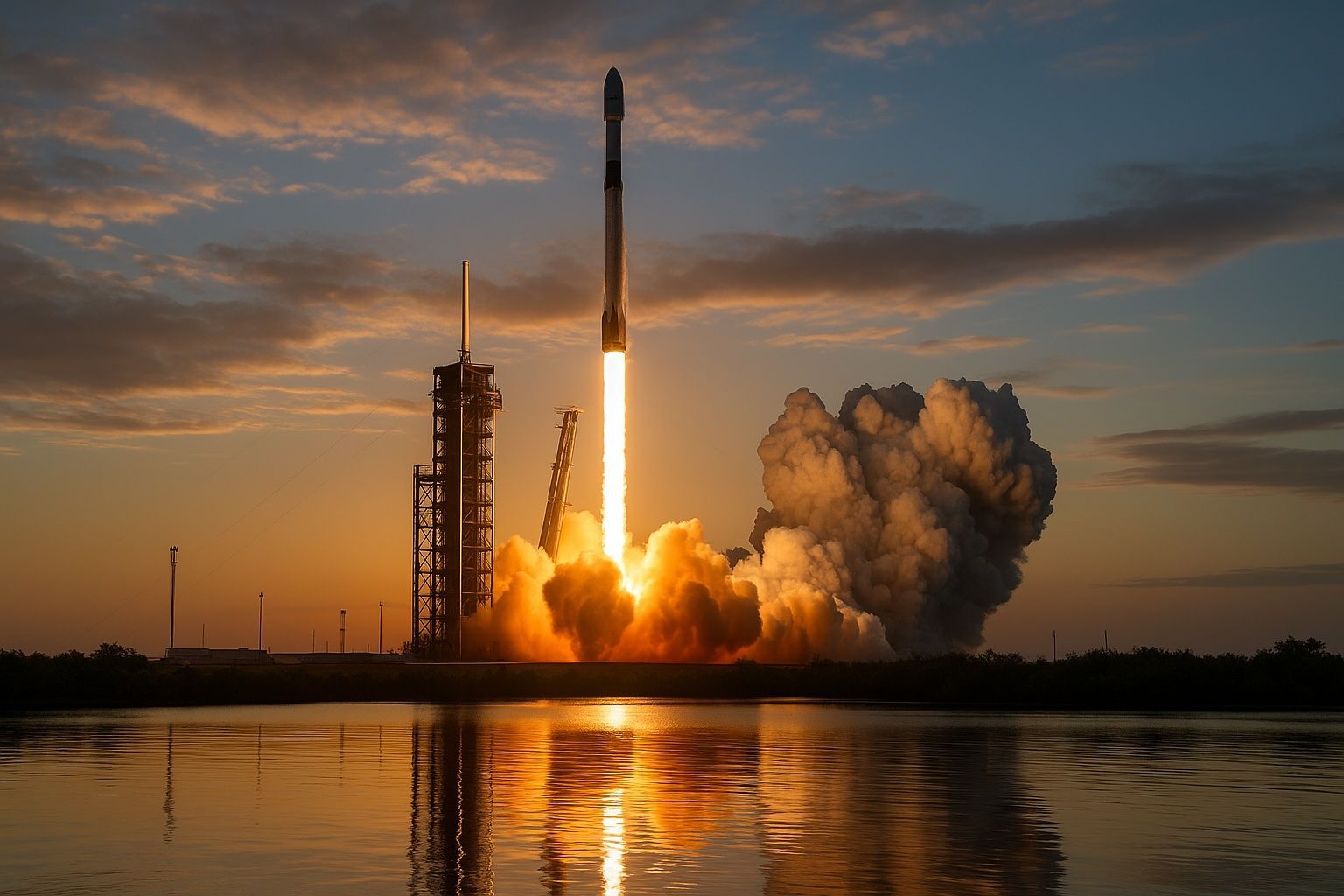- By early 2025, Starlink was available in over 100 countries across every inhabited continent.
- In the past year, Starlink launched in 42 new countries and territories and surpassed 6 million active customers worldwide.
- In the United States, the standard Starlink plan costs about $90 per month with a $599 equipment kit.
- SpaceX added about 2,300 satellites in the past year, bringing the total in orbit to over 7,000.
- By early 2025, Starlink was adding about 5 terabits per second of capacity per week to the constellation.
- Starlink typically delivers 50–200 Mbps download speeds, with the US median peak around 200 Mbps as of mid-2025.
- Latency is typically 25–50 ms, with the US median latency around 25.7 ms during peak hours.
- Reliability is high, with uptime typically well above 99%, aided by inter-satellite laser links that route data between satellites to avoid ground outages.
- China prohibits Starlink receiver imports and is developing its own rival system, while India moved toward licensing with conditions that could enable live service by late 2025.
- Starlink Direct to Cell has been demonstrated with T-Mobile, enabling satellite text messages in 2024 and aiming for voice and data by 2025.
Starlink’s Global Takeover: 100+ Countries Now Online – Speeds, Reviews & Latest Updates
SpaceX’s Starlink satellite internet network has rapidly expanded around the globe, bringing high-speed broadband to regions once deemed unreachable. As of 2025, Starlink is operational in over 100 countries across North America, Europe, South America, Africa, Asia, and Oceania [1]. In just the past year, the service launched in 42 new countries and territories, helping drive its user base to more than 6 million active customers worldwide [2]. This report breaks down where Starlink is available, how its rollout differs by region, what performance users are seeing in each area, and what recent developments mean for the future of this ambitious project.
Where Is Starlink Available in 2025?
Starlink’s coverage now spans a huge portion of the globe. North America was first – the United States (including Alaska, Hawaii and territories like Puerto Rico and Guam) and Canada have had service since 2020–2021. Europe quickly followed; today Starlink is active in most European countries (the UK, Germany, France, Italy, Spain, Poland, and at least 25+ others) [3]. Latin America has seen a broad rollout as well: Mexico and virtually all of Central America, plus large parts of South America (Brazil, Chile, Argentina, Colombia, Peru, Ecuador and more) now have Starlink service. Asia-Pacific availability is growing, with notable markets like Japan, the Philippines, Malaysia, and Indonesia online, alongside Australia, New Zealand and many Pacific Island nations [4]. In Africa, Starlink reached at least 18 countries by early 2025 [5] – including Nigeria, Kenya, Rwanda, Mozambique, Malawi, Zambia, and others – with more on the way as licensing is approved. In the Middle East, new launches in Qatar (2024) and Bahrain, Oman, Jordan, Yemen (2024–2025) have brought Starlink to the region [6].
All told, Starlink’s footprint now covers every inhabited continent. Even some tiny or remote territories have joined the network – from island nations like Fiji, Tonga, and Samoa in Oceania to far-flung spots like Easter Island (Chile) and the Solomon Islands [7] [8]. By early 2025, SpaceX confirmed it had “Starlink available in over 100 countries” and was continuing to expand coverage as fast as launches and regulations allow [9] [10].
However, a few notable holdouts remain. India, for example, has a huge potential market but has not yet granted Starlink full operating permission. Likewise, Pakistan, Saudi Arabia, the UAE, South Africa and some others are still pending regulatory approval as of 2025 [11]. Starlink’s interactive availability map labels these regions as “Coming Soon,” meaning service is contingent on government clearance or additional satellite coverage. Meanwhile, China has effectively barred Starlink entirely, citing security concerns – prompting China to develop its own rival low-Earth orbit systems instead. In short, Starlink’s reach is already global in scope, but regulatory barriers in a few large countries mean it isn’t quite everywhere yet.
Availability and Rollout Stages by Region
Starlink’s journey from limited beta to full public service has differed by region. In its early days (2020–2021), Starlink ran a “Better Than Nothing” beta in North America and parts of Europe, where early users could sign up with the understanding that coverage was still being fine-tuned. Since then, the company has largely moved to full commercial service in areas where it’s licensed – there’s no longer an official “beta” tag on the product in most countries. New country launches sometimes begin with a soft launch or pilot program (for example, a free trial was offered in the tiny Pitcairn Islands before regular service began) [12], but generally once approval is in place, any resident or business can order Starlink hardware and a subscription.
That said, capacity constraints in popular zones have introduced waitlists in some areas. Starlink’s cell-based network can get saturated if too many users in one region come online before more satellites arrive. In countries like the US and UK, certain high-demand regions hit capacity limits; new customers there must “order to reserve your place” and wait as SpaceX adds network capacity [13]. This waitlist scenario is essentially a temporary limitation – SpaceX continuously launches new satellites (often weekly), and with each batch the network can serve more people. Over the last year, the company added about 2,300 satellites (bringing the total to over 7,000 in orbit) and dramatically increased total bandwidth [14] [15], which has helped alleviate many waitlists. Still, in pockets of heavy use (e.g. parts of rural England or California), you might not get “instant” activation if all current satellite capacity is spoken for.
In regions newly coming online, Starlink often labels service as “pending” or “coming soon” until the ground infrastructure and regulatory go-ahead are in place [16]. For example, India had tens of thousands of eager pre-orders, but authorities told SpaceX to hold off until a license was issued. As of mid-2025, India’s government signaled it is finally prepared to greenlight Starlink – but with strict conditions on how the service operates (including requirements for local monitoring and content filtering) [17] [18]. SpaceX has even partnered with Indian telecom giants Reliance Jio and Bharti Airtel to potentially distribute Starlink once fully approved [19], suggesting a large-scale rollout is planned as soon as they get the official nod. Until such approvals are sorted, users in these countries remain on the waiting list, watching the skies (and the news) for updates.
Residential vs. Commercial Availability: In every country where Starlink is live, the standard Residential service is offered to ordinary consumers. Additionally, Starlink has introduced specialized plans like “Roam” (formerly Starlink RV) for portable use, and Starlink Business (also called Priority) for enterprise or government customers needing higher throughput. Generally, if Starlink is licensed in a country, all these tiers – including maritime and aviation services for ships and planes – are permitted as well [20]. One nuance is that some regulators restrict using Starlink on the move: for instance, Japan and Mexico allow the portable dish but only when stationary (no using it while driving in an RV) [21] [22]. But overall, both individual homes and commercial users (airlines, shipping companies, ISPs, etc.) can tap into Starlink wherever it’s officially active. It’s not just a residential backyard dish network – it’s being adopted for cruise ships, private jets and even humanitarian deployments around the world.
Performance: Speed, Latency and Reliability Across Regions
One of Starlink’s biggest selling points is that it can deliver broadband speeds and low latency comparable to ground-based internet. How well does it live up to that promise? The answer, as of 2025: in many places surprisingly well, though performance can vary by region and network load.
Download Speeds: SpaceX says Starlink users should see anywhere from 50 Mbps up to 200 Mbps or more in download bandwidth [23]. Real-world tests confirm that many customers indeed get 100+ Mbps under good conditions. In fact, SpaceX reported that in the United States – which now has over 2 million Starlink users – the median download speed during peak hours is nearly 200 Mbps as of mid-2025 [24]. Even Starlink’s new lower-priced tier still provides around 100 Mbps down / 20 Mbps up for most U.S. users [25], a huge leap over previous satellite services.
Speeds in other countries show a mixed but generally positive picture. In Europe, where Starlink has hundreds of thousands of subscribers, typical speeds range in the tens to low hundreds of Mbps. For example, in Q4 2024 the UK’s median Starlink download was ~87 Mbps (with ~13 Mbps upload) [26]. Some European countries saw higher medians – Hungary topped the charts at ~135 Mbps download, and Romania led in uploads at ~23.5 Mbps [27]. Meanwhile, heavily subscribed areas like Germany had lower results (median ~65 Mbps in late 2024) after a surge of new users caused congestion [28]. The good news is that after a period of decline in 2023, Starlink speeds in Europe began to stabilize and even tick upward by the end of 2024, thanks to capacity upgrades [29]. This suggests SpaceX is managing to add satellites and ground stations fast enough to keep up (mostly) with the growing demand.
In emerging markets, Starlink’s performance has often been fast out of the gate, then moderated as more users come on board. Early adopters in the Philippines saw blazing speeds above 100 Mbps [30], but once the service scaled up, the median fell to about 48 Mbps by mid-2024, which actually trailed the country’s fiber broadband average [31]. Likewise, in Nigeria initial tests showed around 60–70 Mbps typical downloads [32] – impressive for areas that previously had almost no broadband – but those speeds may fluctuate with network load. It’s worth noting that even at ~50 Mbps, Starlink is often transformative in rural parts of these countries. In other words, Starlink might not outpace urban fiber in Manila or Lagos, but it can far exceed what’s available in the provinces. As one tech analyst put it, Starlink essentially “fast forwarded” remote communities “from 2005 to 2025” in terms of internet access quality [33]. The mere ability to get tens of megabits in a village that used to have dial-up (or nothing at all) is game-changing.
Latency: Because Starlink satellites orbit much closer to Earth than traditional satellites, latency (the delay in sending/receiving data) is dramatically improved. Users generally experience latency comparable to a decent DSL or 4G connection. In fact, Starlink now often achieves 25–50 ms ping times [34]. Lower is better – and 25–50 milliseconds is roughly on par with wired broadband, enabling smooth video calls and online gaming. Across Europe, Starlink’s latency decreased significantly from 2023 to 2024, with median latency dropping by double-digit percentages in many countries [35]. The UK recorded an impressive 41 ms median latency (the best in Europe) in late 2024 [36]. In the U.S., SpaceX claims the median latency during peak hours is now about 25.7 ms nationwide [37], with fewer than 1% of sessions exceeding 55 ms. These numbers are actually better than some cable/DSL providers can manage and vastly better than legacy geostationary satellites (which often had 600+ ms delays). SpaceX has even set an internal goal of eventually hitting a stable 20 ms median latency [38] – effectively negligible delay – and is working on software and satellite networking optimizations to reach that.
Reliability: Starlink’s distributed satellite constellation has shown to be quite resilient. With a fleet of satellites overhead (typically a given user can see several at any time) and numerous ground gateways, the network can route around problems. SpaceX points out that Starlink kept customers online through events that knocked out terrestrial networks, such as fiber cable cuts and power outages, by re-routing data via space until ground links recovered [39] [40]. The mesh of inter-satellite laser links, now active on newer Starlink satellites, allows data to hop across satellites in orbit, bypassing any damaged ground infrastructure [41]. This was demonstrated when Starlink dishes continued working during natural disasters – for example, during wildfires in Maui and hurricanes in Florida, first responders were able to stay connected via Starlink even as local internet lines went down [42].
Day to day, users report that Starlink generally provides a stable connection suitable for streaming, Zoom calls, and cloud applications. Of course, it’s not perfect: heavy rain or storms can occasionally disrupt the signal (a phenomenon known as rain fade) for a short time [43], and any obstructions (trees, buildings) that block the dish’s view of the sky will cause dropouts until the satellite comes back into line of sight. However, overall uptime is high, typically well above 99%, since satellites pass in quick succession and the system switches seamlessly to a new one if one link is interrupted. Users in tropical regions have noted that intense downpours may knock the connection out for a minute or two, but the “mesh” of many satellites mitigates extended downtime – service resumes quickly after the storm cell moves or a new satellite comes overhead [44]. In practical terms, this reliability means people can treat Starlink much like a normal broadband service, with only occasional blips.
User Experiences and Reviews Around the World
Starlink’s impact is perhaps best understood through the eyes of its users. In rural and remote areas, the feedback has been overwhelmingly positive – often bordering on astonishment. Communities that lacked modern internet are suddenly getting connectivity that rivals urban broadband. For instance, in the Brazilian Amazon, SpaceX partnered with local authorities to deploy Starlink at remote schools, allowing kids in rainforest villages to access online learning for the first time [45]. In Chile’s Patagonia, residents went from sub-5 Mbps connections (or no internet at all) to 50–100 Mbps via Starlink, enabling online education and telemedicine in places that were digital black holes before [46]. Even on Easter Island, one of the most isolated inhabited places on Earth, Starlink’s arrival meant the island’s 7,000 residents could finally enjoy speeds above 50 Mbps, a night-and-day improvement from the crawling connection they used to suffer [47] [48].
Many rural users describe Starlink in almost life-changing terms. In northwest Alaska, a local photographer named Eben Hopson had his town’s only fiber line cut by arctic ice – so he switched to Starlink. “It’s been a game changer,” Hopson said. “You bring a Starlink dish out there and plug it in. Two minutes later, you’ve got the whole world again in the palm of your hand.” [49]. That sense of restored connectivity – instant internet where previously there was nothing – is a common refrain. A retiree in rural Washington state similarly compared his old DSL (10–20 Mbps on a good day) to Starlink’s 100+ Mbps service and said, “There’s really no comparison… [with Starlink] we get 100 or 200 Mbps and it’s reliable,” calling the upgrade downright transformative [50].
Even customers in more developed areas have found Starlink a compelling alternative, especially if they were stuck with only one slow ISP. Subscribers often praise the plug-and-play simplicity – the kit comes pre-configured, so setup involves little more than mounting the dish and turning it on, letting it automatically lock onto satellites. Within minutes, one can be online without any technician visit. For digital nomads and RV travelers, the Starlink Roam service has enabled broadband on the go, allowing work and streaming from campsites or road trips that previously had zero coverage.
On the other hand, critics and challenges have surfaced too. As Starlink gained popularity, some users noticed speeds could dip during peak times, especially in 2022–2023 when the constellation was still ramping up. Forums saw complaints of performance slowing as more neighbors got dishes – a sign that Starlink wasn’t immune to network congestion. This prompted concerns that the network could become oversubscribed. SpaceX responded by accelerating satellite launches and introducing higher-tier plans (with “Priority” data for Business users) to manage traffic. By late 2024, independent tests suggested the decline had leveled off and speeds were rebounding in many areas [51]. Still, experts caution that Starlink’s capacity is ultimately finite per satellite, so in densely populated regions it might never fully replace fiber networks. As one industry analyst put it, Starlink is “a game changer for rural users” but not a threat to urban fiber providers – its strength is serving the unserved, not trying to be the primary ISP in Manhattan or London.
Another critique has come from the astronomy and science community. The sheer number of Starlink satellites launched (and thousands more planned) has raised alarm about night-sky light pollution and orbital debris. Astronomers have reported Starlink satellites photobombing telescope images, and there’s worry that so many objects increase the risk of collisions in orbit. SpaceX has taken steps to mitigate this – such as adding sunshades and anti-reflective coating to satellites to dim their brightness, and designing satellites to burn up completely on re-entry – but not everyone is satisfied. Regulatory bodies like the U.S. FCC and international agencies are now grappling with how to ensure megaconstellations like Starlink operate safely and sustainably. SpaceX, for its part, often points out its commitment to responsible space operations, noting that Starlink uses autonomous collision avoidance and that satellites are in low orbits where they decay within 5 years if malfunctioning [52] [53]. The debate is ongoing: how to balance expanding internet access with protecting the space environment.
Cost is another consideration users mention. The price of Starlink has been trending downward in many regions (especially as competition and economies of scale kick in), but the upfront hardware cost and monthly fee are still significant. In the U.S., the standard plan costs around $90 per month (recently reduced in many areas from the original $99) plus a $599 equipment kit. In some developing countries, SpaceX has introduced regional pricing – for example, in Nigeria and Brazil the monthly fee has been cut roughly in half to around $40–$50 to be more affordable [54]. Despite these adjustments, a $600 dish is out of reach for some low-income households. Governments and NGOs have stepped in in a few cases, subsidizing Starlink units for community use (like village Wi-Fi hubs or connecting rural clinics). Over time, as production scales up and perhaps with the advent of a smaller “Starlink Mini” dish (which SpaceX has teased as a portable, lower-cost unit), the hope is that costs will come down further.
Importantly, customer satisfaction surveys show Starlink scoring very well among its target demographic. In one survey of rural American broadband users, Starlink achieved a Net Promoter Score of +42, whereas traditional ISP customers in those areas averaged a dismal –21. In plainer terms, rural Starlink subscribers are far happier with their service than people stuck on legacy rural ISPs, despite Starlink’s occasionally inconsistent speeds. Many users express a sense of relief – Starlink has freed them from the old monopolies that offered sluggish or no internet. “Starlink revolutionized internet access in rural America seemingly overnight,” one tech journalist wrote, noting that while it accounts for only ~1% of U.S. internet subscriptions, that 1% represents some of the hardest-to-connect homes finally getting online [55] [56].
Recent News: Expansion Plans, Regulatory Hurdles, and Partnerships
The past year has been eventful for Starlink. SpaceX’s relentless launch schedule (often multiple rocket launches per month dedicated to Starlink) is continuing as the company works to bolster capacity and extend coverage. In 2023, SpaceX began deploying its next-generation V2 mini satellites, which have four times the capacity of the earlier models [57]. This led to notable improvements: by early 2025, SpaceX was adding about 5 terabits per second of capacity each week to the constellation [58], and Starlink’s previously declining speeds started to climb back up in various regions [59]. SpaceX is also eager to start using its new Starship rocket for Starlink launches – Starship can carry far larger V2 satellites (or many more at once), potentially enabling 1 Tbps super-satellites in the future [60]. Though Starship’s debut has been slower than hoped due to testing mishaps, it’s seen as a key to keeping Starlink ahead of growing demand.
On the regulatory front, Starlink faces a patchwork of rules as it enters each new country. Some recent developments: In Europe, SpaceX has been seeking access to additional radio spectrum (such as E-band frequencies for satellite-to-ground links). European regulators have been cautious – for instance, the Italian government in 2025 delayed a decision on Starlink’s E-band request until the EU can form a unified stance on spectrum sharing [61]. There’s also strategic maneuvering in Europe to reduce reliance on foreign satellite systems: the EU announced plans for its own multi-billion-euro constellation (IRIS²) and countries like France and the UK have mused about building sovereign satcom networks [62] [63]. This comes partly in response to Starlink’s prominence, especially after seeing how Ukraine relied on Starlink during conflict – governments realize critical communications could be at the mercy of a private company. As a result, while regulators have generally approved Starlink for consumer use, some are also investing in domestic alternatives or imposing conditions to maintain oversight.
Perhaps the most dramatic regulatory story has been India, a market with huge need (tens of millions lacking broadband) but stringent telecom laws. After initially ordering Starlink to stop taking preorders in 2021, Indian authorities have gradually warmed up. In May 2025, India’s Department of Telecommunications signaled readiness to grant licenses to Starlink and others, but only if they adhere to very strict requirements: Starlink would have to register every user terminal, geo-fence them to prevent unauthorized use, log all user traffic metadata, and even shut off service in “special monitoring zones” near sensitive border areas where the government wants full surveillance [64] [65]. Additionally, Starlink must guarantee it can filter or block content to comply with Indian censorship laws (e.g. blocking any websites the government deems illegal) [66]. These conditions go beyond what most countries require, essentially treating Starlink like any other ISP under Indian law, including surveillance mandates. Elon Musk has been courting Indian officials – he personally lobbied Prime Minister Modi in mid-2023 to allow Starlink – and SpaceX has lined up partnerships with major Indian telecom operators to distribute the service once approved [67]. Reports in July 2025 suggest India’s space regulator finally granted a letter of intent for Starlink’s commercial launch [68], meaning live service could start by late 2025 if all goes well. India could quickly become one of Starlink’s largest user bases, but it will also be operating under some of the world’s tightest regulatory oversight.
In other regions, Starlink has navigated various hurdles: Pakistan is exploring rules for satellite internet but has national security concerns. Several African governments have fast-tracked Starlink approvals to help connect rural schools and hospitals, often working in partnership with SpaceX (for example, Nigeria and Rwanda both welcomed Starlink in 2023 as part of digital inclusion initiatives). Russia, unsurprisingly, has banned Starlink usage internally and threatened penalties for anyone using it, viewing it as a tool of Western influence. And as mentioned, China prohibits Starlink receiver imports and is launching its own satellites instead. By and large, though, Starlink’s expansion has been embraced by countries looking to close digital gaps – the hold-ups tend to be about how to integrate it with national telecom frameworks and security requirements, rather than outright rejection of the service.
Meanwhile, SpaceX has struck key partnerships to extend Starlink’s reach beyond just home broadband. One headline-grabbing initiative is Starlink Direct to Cell: SpaceX is working with mobile carrier T-Mobile in the U.S. (and with other carriers in New Zealand and elsewhere) to use Starlink satellites as a direct backhaul for ordinary cell phones. In early 2024 they successfully sent text messages via satellites to an off-the-shelf phone using T-Mobile’s spectrum [69]. The plan is to offer basic text coverage across the U.S. for T-Mobile customers via satellite by the end of 2024, with voice and data to follow in 2025 as more advanced satellites come online [70]. This would essentially fill in cellular dead zones (over 500,000 square miles in the U.S. have no cell signal) with low-bandwidth connectivity from space [71]. If it works, it could be revolutionary for emergency communications and rural connectivity, and SpaceX has said any carrier in the world can partner for similar capability. Other partnerships include deals with airlines: several carriers such as Hawaiian Airlines, Air France, Japan’s ANA, and Delta have signed on to equip their aircraft with Starlink for in-flight Wi-Fi, given Starlink’s ability to provide hundreds of Mbps to a plane. Cruise lines like Royal Caribbean and Carnival have likewise installed Starlink on ships to improve internet at sea. These commercial tie-ups not only open new revenue streams for SpaceX but also broaden Starlink’s visibility (many travelers in 2024–2025 might use Starlink Wi-Fi on a flight or cruise without even realizing it).
SpaceX executives remain bullish on Starlink’s mission. Gwynne Shotwell, SpaceX’s President and COO, has emphasized that reaching the most remote users will require satellite tech. “I don’t think the math works [to connect everyone] without Starlink or basically an LEO provider,” Shotwell said in mid-2024, arguing that even with massive fiber-optic projects, satellite is “necessary to reach the most far-flung places.” [72] Underlining that point, some U.S. states are already subsidizing Starlink for extremely hard-to-reach homes where running fiber would be astronomically expensive. A Texas broadband official estimated it could cost $120,000+ per household to wire up certain rural areas with fiber, which is why alternatives like Starlink make sense there [73]. SpaceX is actively engaging with the U.S. government’s BEAD program (a $42 billion rural internet fund) to make sure satellite solutions are included for those high-cost areas [74] [75].
Elon Musk himself often speaks to Starlink’s grander vision. He has described Starlink as a “staggeringly difficult” engineering project, noting “we had to invent so much technology from scratch” because nothing like it had been built before [76]. The payoff, in Musk’s view, is creating the first truly global, high-bandwidth internet system – one that can reach places terrestrial networks can’t. As of 2025, that bold vision is becoming reality on the ground (and in the skies): millions of people from the Alaskan tundra to the African savannah are logging onto Starlink and experiencing broadband for the first time.
The Bottom Line
In just a few years, Starlink has evolved from a limited beta in a handful of countries into a worldwide service connecting over 100 countries’ residents and businesses [77]. It has proven that satellite internet at scale can deliver fast, low-latency service, shattering the old notion that satellite means slow, laggy connections. Performance reviews indicate generally strong speeds (often 50–150 Mbps) and latency around 30–40 ms in most regions, with improvements as the network grows [78] [79]. Customer feedback – especially from rural areas – highlights how Starlink is bridging the digital divide, bringing modern internet to communities long left offline [80] [81]. At the same time, Starlink faces challenges: keeping up with user demand, navigating complex regulatory regimes, mitigating its impact on astronomy, and fending off emerging competitors (from Amazon’s Project Kuiper to new government-backed constellations).
For now, SpaceX’s Starlink enjoys a lead in the new space-based internet race. Its partnership strategy (from telecom collaborations to serving airlines and disaster zones) is extending its utility beyond just home use. As expansion continues – with big markets like India likely coming online and next-gen satellites boosting capacity – 2025 is poised to be the year Starlink truly goes mainstream. In the words of an early user, having Starlink is like holding “the whole world in the palm of your hand.” [82] It’s a hyperbolic statement that carries a kernel of truth: Starlink’s global coverage means information, communication, and opportunity are reaching places where the world once felt very far away. The coming years will reveal just how much this growing network can change lives on Earth, even as its satellites streak silently overhead.
Sources: Official SpaceX/Starlink updates, telecommunications reports, and user reviews have been cited throughout for accuracy and context. Key references include Starlink’s own network update (July 2025) [83] [84], performance analyses by Ookla and others [85] [86], expert commentary from broadband industry observers [87] [88], and statements from SpaceX leadership and global regulators on Starlink’s rollout [89] [90].
References
1. technologymagazine.com, 2. www.starlink.com, 3. ts2.tech, 4. ts2.tech, 5. www.statista.com, 6. ts2.tech, 7. ts2.tech, 8. ts2.tech, 9. technologymagazine.com, 10. technologymagazine.com, 11. ts2.tech, 12. en.wikipedia.org, 13. www.starlink.com, 14. www.starlink.com, 15. www.starlink.com, 16. www.starlink.com, 17. www.theregister.com, 18. www.theregister.com, 19. www.theregister.com, 20. ts2.tech, 21. ts2.tech, 22. ts2.tech, 23. technologymagazine.com, 24. www.starlink.com, 25. www.starlink.com, 26. www.ispreview.co.uk, 27. www.ispreview.co.uk, 28. www.ispreview.co.uk, 29. www.ispreview.co.uk, 30. www.gsma.com, 31. cebudailynews.inquirer.net, 32. www.gsma.com, 33. broadbandbreakfast.com, 34. www.ispreview.co.uk, 35. www.ispreview.co.uk, 36. www.ispreview.co.uk, 37. www.starlink.com, 38. www.starlink.com, 39. www.starlink.com, 40. www.starlink.com, 41. www.starlink.com, 42. www.starlink.com, 43. ts2.tech, 44. ts2.tech, 45. ts2.tech, 46. ts2.tech, 47. ts2.tech, 48. ts2.tech, 49. broadbandbreakfast.com, 50. broadbandbreakfast.com, 51. www.ispreview.co.uk, 52. www.starlink.com, 53. www.starlink.com, 54. ts2.tech, 55. broadbandbreakfast.com, 56. broadbandbreakfast.com, 57. www.starlink.com, 58. www.starlink.com, 59. www.ispreview.co.uk, 60. www.ispreview.co.uk, 61. technologymagazine.com, 62. technologymagazine.com, 63. technologymagazine.com, 64. www.theregister.com, 65. www.theregister.com, 66. www.theregister.com, 67. www.theregister.com, 68. www.newindiaabroad.com, 69. www.starlink.com, 70. www.starlink.com, 71. technologymagazine.com, 72. www.fierce-network.com, 73. broadbandbreakfast.com, 74. www.fierce-network.com, 75. www.fierce-network.com, 76. technologymagazine.com, 77. technologymagazine.com, 78. www.ispreview.co.uk, 79. www.ispreview.co.uk, 80. broadbandbreakfast.com, 81. broadbandbreakfast.com, 82. broadbandbreakfast.com, 83. www.starlink.com, 84. www.starlink.com, 85. www.ispreview.co.uk, 86. www.ispreview.co.uk, 87. broadbandbreakfast.com, 88. www.fierce-network.com, 89. www.theregister.com, 90. technologymagazine.com
